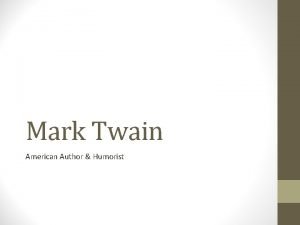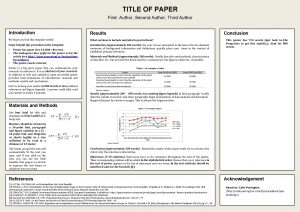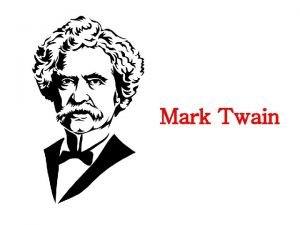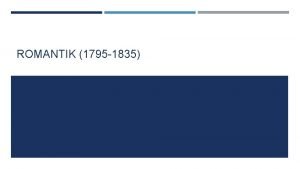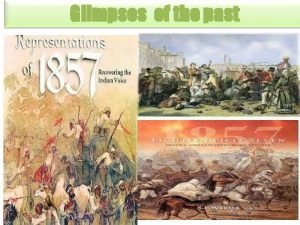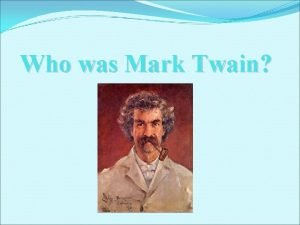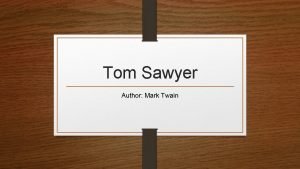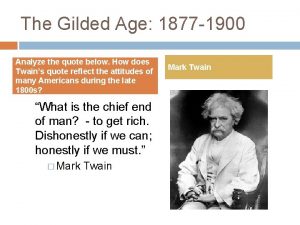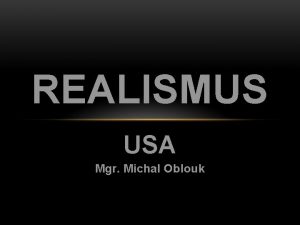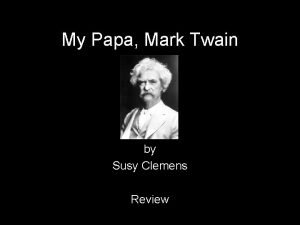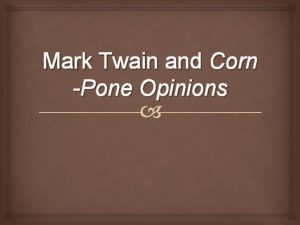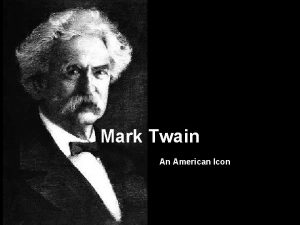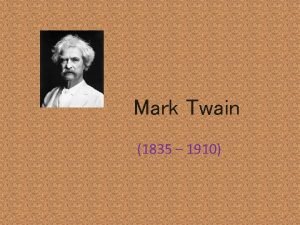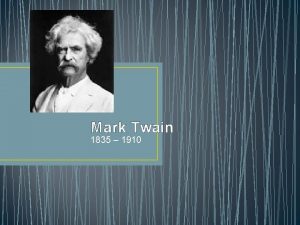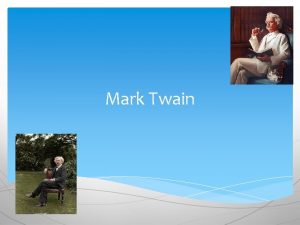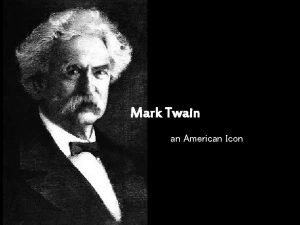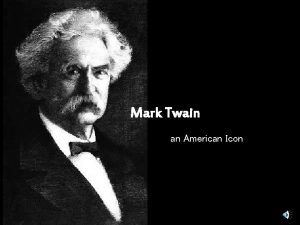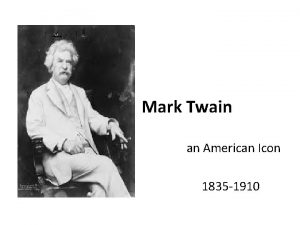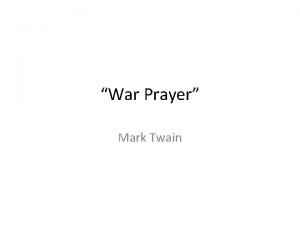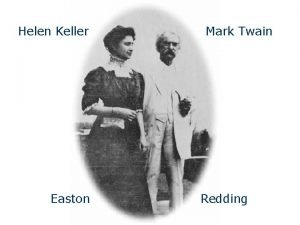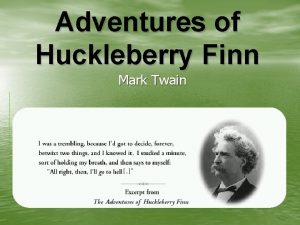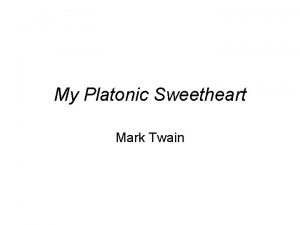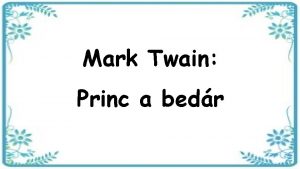Mark Twain American Author Humorist Mark Twain 1835















- Slides: 15

Mark Twain American Author & Humorist

Mark Twain (1835 -1910) • Real name: Samuel Langhorne Clemens • Grew up in Hannibal, Missouri • His formal education ended at 12, after his father’s death in 1847. • As a young man Twain worked as a riverboat pilot on the Mississippi River. When he started his writing career, Samuel Clemens adopted the name “Mark Twain, ” which meant two fathoms, a safe depth for a riverboat.

• In 1861, Samuel Clemens avoided the brewing Civil War by going west. He took his first writing job as reporter at the Virginia City Territorial Enterprise. Ø Twain combined his writing with public lecturing and foreign traveling, acquiring an international reputation as humoristic-frontierphilosopher. Ø By 1900 Twain had become America’s foremost celebrity. He was invited to attend ship launchings, anniversary gatherings, political conventions, and countless dinners.

“The Notorious Jumping Frog of Calaveras County, ” 1865 • With the publication of his frontier tale, “The Celebrated Jumping Frog of Calaveras County”, Twain became nationally famous. • Twain claims to have overheard the story he bases “The Notorious Jumping Frog…” while he was staying at the Angels Hotel. • Twain learned two things from listening to storytellers: • -the manner in which a person tells a story is what makes it funny. • -a successful humorist should always presented to be serious

“The Notorious Jumping Frog of Calaveras County, ” CONTD. o This story is an example of a tall tale. -A distinctly American form of humorous story -It’s humor comes from the use of local color or regionalism. o “The Notorious Jumping Frog” is written in a frame narrative.

Twain’s Literary Style: Realism and Regionalism • Local Color: Literature that focuses on the characters, dialect, customs, topography, and other features particular to a specific region that exploits the speech, dress, mannerisms, and habits of that specific region.

Tall Tales • Humorous situations • Wildly exaggerated details • Bold, but sometimes foolish, characters • Characters with extraordinary or superhuman abilities • Not intended to be believable

Frame Narrative • A plot structure which involves telling one story within another story

Elements of Humor • Writing intended to evoke laughter. • Many western humorists of the 1800 s perfected these comic techniques: • Exaggerating and embellishing incidents • Using a narrator or story teller who takes a serious tone, adding humor by suggesting that the teller of the tale is unaware of its ridiculous qualities

Satire • Satire: The literary art of ridiculing a folly or vice in order to expose or correct it • For example, in a “A Modest Proposal” by Jonathan Swift, Swift suggests that the impoverished Irish might ease their economic troubles by selling their children as food for rich gentlemen and ladies. This satirical hyperbole mocks heartless attitudes towards the poor, as well as Irish policy in general.

Humorous Dialect • Dialect: the usage or vocabulary that is characteristic of a specific group of people is called dialect. • Ring Lardner uses dialect to create humor in You Know Me Al: "I says Well I won the pot didn't I? He says Yes and he called me something. I says I got a notion to take a punch at you. He says Oh you have, have you? And I come back at him. I says Yes I have, have I? I would of busted his jaw if they hadn't stopped me. "

Understatement • Understatement : When an author deliberately understates the obvious, he or she is using understatement. • Shakespeare uses understatement in Romeo and Juliet with one of his wittiest creations: In Act II, scene i, Mercutio describes his mortal wound "not so deep as a well, nor so wide as a church door; but 'tis enough, 'twill serve. " More recent examples include Mark Twain's famous "The reports of my death have been greatly exaggerated“.

Hyperbole • Hyperbole: The opposite of understatement, a writer uses hyperbole to exaggerate his or her point to create humor. • Paul Bunyan is one of America’s great folk heroes. His stories of legend are full of hyperbole – in fact he and his great Blue Ox Babe were examples of hyperbole themselves. One story read, "Well now, one winter it was so cold that all the geese flew backward and all the fish moved south and even the snow turned blue. Late at night, it got so frigid that all spoken words froze solid afore they could be heard. People had to wait until sunup to find out what folks were talking about the night before.

Comic Irony • A writer creates comic irony by stating one thing while meaning another. It is an application of verbal irony used with humorous intent. • In his speech "Advice to Youth" Twain mocks standard wisdom: "If a person offends you, and you are in doubt as to whether it was intentional or not, do not resort to extreme measures; simply watch your chance and hit him with a brick. "

• As you read, identify aspects of humor: -Comic Irony -Satire -Understatement -Hyperbole -Humorous Dialect
 Examples of understatement in the notorious jumping frog
Examples of understatement in the notorious jumping frog Mark twain the famous american author was well known
Mark twain the famous american author was well known First author second author third author
First author second author third author Mark twain the father of american literature
Mark twain the father of american literature Mark twain american literature
Mark twain american literature Historischer hintergrund romantik
Historischer hintergrund romantik Dissatisfaction (1835-56)
Dissatisfaction (1835-56) The romanticism (1795 — 1835) what is romanticism
The romanticism (1795 — 1835) what is romanticism Mark twain wife
Mark twain wife Mark twain realismus
Mark twain realismus Tom sawyer author
Tom sawyer author Mark twain gilded age quote
Mark twain gilded age quote Mark twain realismus
Mark twain realismus Mark twain father
Mark twain father Corn pone opinions summary
Corn pone opinions summary Mark twain icon
Mark twain icon
